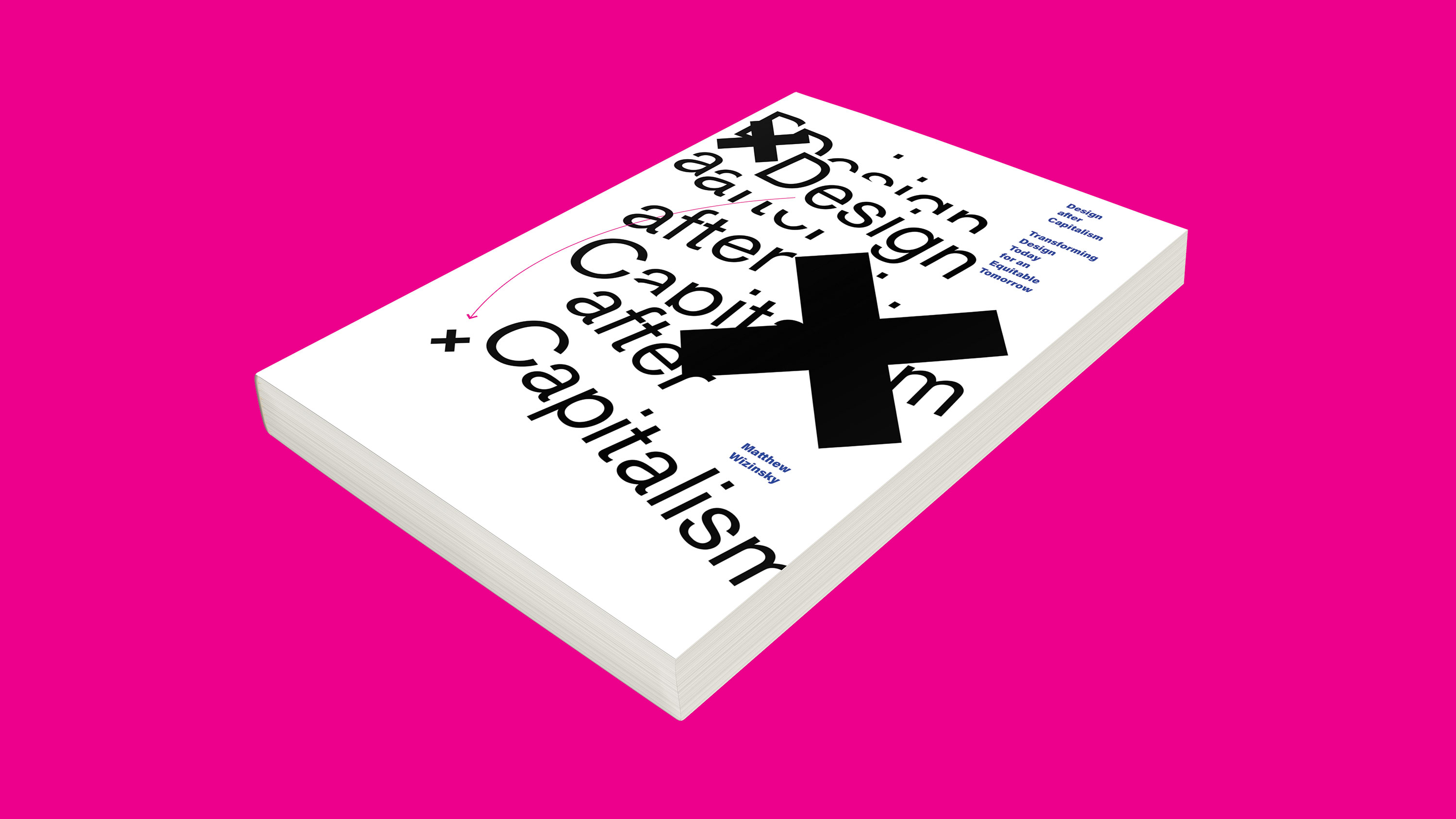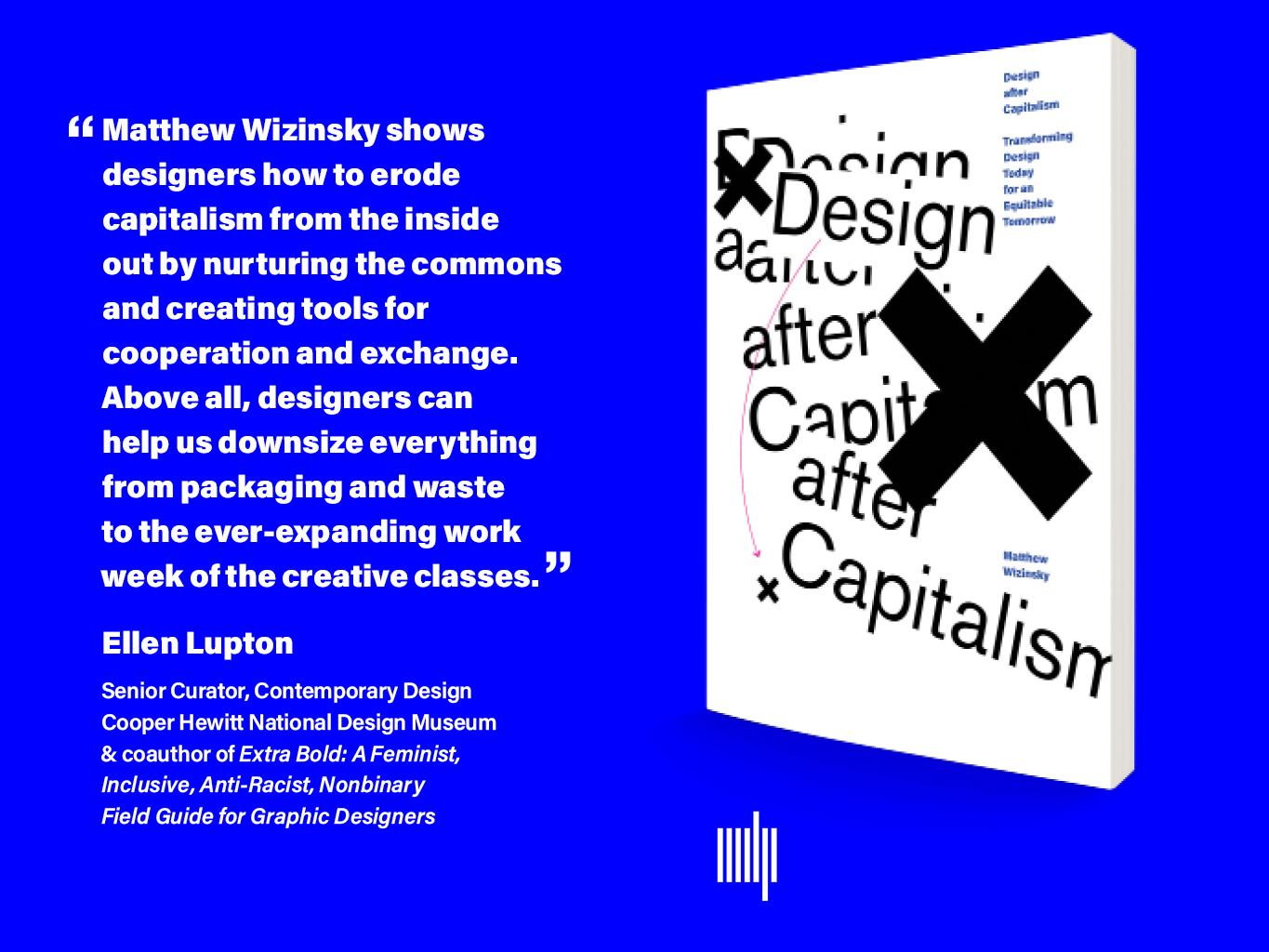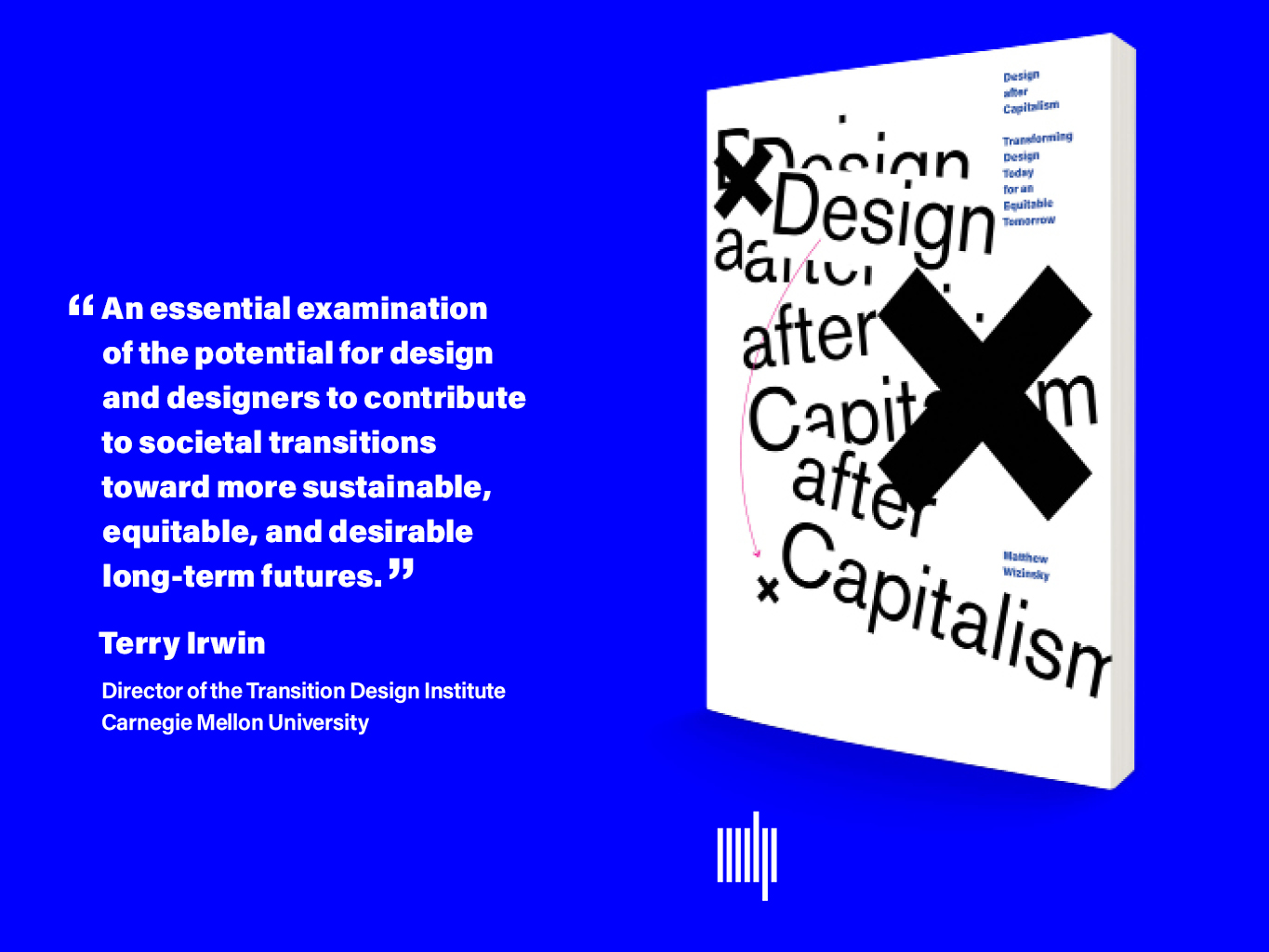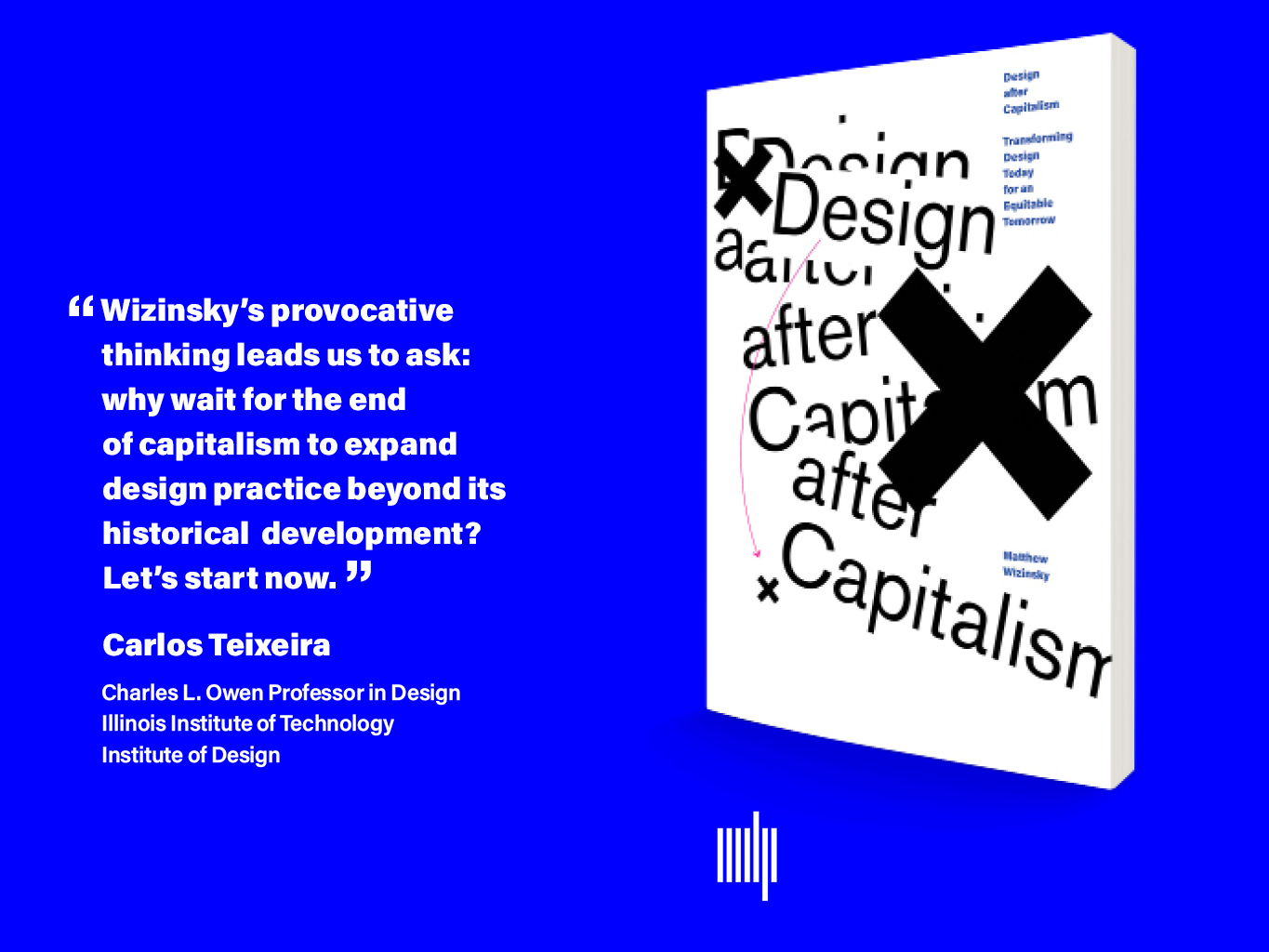Design After Capitalism
MONOGRAPH / MIT Press, 2022
In Design after Capitalism, Matthew Wizinsky argues for design practices to reorient toward deliberate transitions of everyday politics, social relations, and economies. Looking at design through the lens of political economy, Wizinsky calls for the field to transcend the logics, structures, and subjectivities of capitalism—to combine design entrepreneurship with social empowerment in order to facilitate new ways of producing those things, symbols, and experiences that make up everyday life.
designaftercapitalism.org ︎
Design after Capitalism at MIT Press ︎
“Visions of Postcapitalist Design
(The MIT Press Reader) ︎

EXCERPTS FROM THE INTRODUCTION
Introduction
Design is world-making.[i] As grandiose as that sounds, the various fields that comprise the territory of Design are organized around intentional production of the objects and symbols that make up everyday lives. Design practices—institutionalized patterns of knowledge and action—contribute to the material culture of the worlds we all inhabit. In the act of designing, designers identify “users” and “use case scenarios,” creating idealized subjects and ways of being in the world. This contributes to determinations about who has what kinds of agency and how those agencies are mediated physically, symbolically, and experientially. Designers are often employed by third-party interests to determine what is produced to achieve these ideals and also how. This describes both sides of the political dimension of design: mediating the everyday lives of “users” by exercising an authority over the objects and experiences that make up those everyday lives. Design alone cannot (and certainly does not) replace politics nor economics nor culture. Yet, design is everywhere, and everywhere it is, it represents and enacts politics, economies, and culture.There is an inherent tension between disciplinary norms and any attempt to change those norms, to re-orient patterns of knowledge and action. This is different from the expansion of Design disciplines witnessed over the past several decades. Designers have taken on greater responsibilities for determining what to produce and how, particularly in the expanding space of digital products and services. This has brought up myriad new challenges, including ethical concerns. However, my proposal is for a fundamental shift in purpose, which requires a conscientious move toward change at a higher systemic level than before. Whereas most design practices, no matter how advanced, systemic, or complex, assume Capitalism as the limit of its transformative actions, this model attempts to extend that limit. Prominent design scholars and historians, even when those critical of this context, tend to accept that Capitalism is the primary ideological container for modern design practices.[ii]
This book proposes a framework, theoretical grounding, and practical principles for Design to transcend the logics, structures, and subjectivities of Capitalism. Most contemporary design practices have evolved out of the historical conditions of industrial Capitalism; however, there are converging forces which point to the possibility that Capitalism is coming to an end; or, at the very least, it is mutating into something quite different. This will pose a problem for the future of design, if designers are not prepared for—or, perhaps, actively engaged in—practicing in ways that anticipate After Capitalism.
Capitalism has long been critiqued for a range of detrimental social, ecological, and political impacts, from the way it alienates people from the objects of their labor to the ways that the logics of competition and commodification seep into everyday social interactions. The forces driving this exploration of design after capitalism are focused on design’s social adaptations to a changing economy. In other words, the argument is as much economic as moral.
First, Capitalism requires constant growth. We are now witnessing both the immediate and long-term destruction of global warming at every level of human and non-human earthly existence. The infinite growth required by Capitalism is at odds with the finite resources of our planet, which is literally burning up from global warming.
Second, digital goods and services and the rapid automation of production, distribution, and the design of all kinds of material “things” may simply be incompatible with market mechanisms alone. Capitalism has impressively adapted itself to changing historical conditions; however, it may not be suited to an economy that is dematerialized, post-industrial, and knowledge-based.
Addressing both of these points, this book critically assesses Design practices operating in an evolving digital information and service economy to propose a transformation that blends design entrepreneurship with social empowerment. To do so, a modified discipline of Design is theorized and historically contextualized, and fundamental principles, strategies, and guidelines for its practice are articulated. The argument builds from evidence and theoretical positions well outside the design of material culture—sociology, economics, political science, history, environmental and sustainability studies, philosophy, critical theory—but returns to design theory and practice with these principles for practice. The assembly of theoretical positions, historical and contemporary case studies, and practical guidelines intend to provide a strong foundation for more broadly connected and intentionally implemented approaches to the practice of a Post-Capitalist Design (PCD).
The principles and practical guidelines put forth here can be put to use now, without the need for political revolution or specific policy reforms. The purpose is to inform and influence designers, design students, as well as professionals and scholars from various fields that interface with design to consider the “institutional” nature of design practices and how they might be more equitably and sustainably modeled through a new disciplinary model. Design itself is synonymous with change. It is about materializing preferable states of the world and, in doing so, to establish preferable ways of being in that world. This is a plea for designers to take their own claims seriously about design’s potential to incite broad and meaningful social change. My hope is that this will help designers to better think what they are doing.
After Capitalism
My argument is not that Capitalism is inherently evil, nor that all capitalist, profit-seeking activity is greedy and manipulative. Capitalism is a social construct. Like any social system, it is embedded with its own contradictions and limits. Most importantly to remember, it is an economic and social organization that has been imagined, implemented, institutionalized, and normalized by people toward certain goals. If those goals are not being achieved, people can modify or discard the system. Capitalism is also an historical system of organization with origins in a very different social and economic context than the present. It was within those historical conditions that modern design emerged. Over several centuries, Capitalism has proven incredibly productive and, at times, has marvelously distributed wealth and increased material prosperity for countless people. However, for a number of reasons to be discussed, that system appears to have run its course. Arguably, this system is no longer credible for claims to the broad distribution of improved livelihoods. As the system exacerbates negative tendencies that were always inherent and positive social contributions diminish, designers are in a position to transform Design practices in order to institutionalize new social and economic organizations within the dying one.The term “After Capitalism” has been prevalent for decades in disciplines engaged in envisioning future states of a more just, rational, and democratic political economy. The term appears in sociological texts, philosophical works, and scholarship in strategic Foresight to describe the next paradigm of political economy and its implications. This term is applied to the concept of a new political economy that is emerging from within Capitalism and might further grow to erode and eventually replace Capitalism. This slow transformation is proposed to develop new social and economic forms tht make use of the productive technological and innovative gains of Capitalism but repurpose them for a more democratic and egalitarian political economy. This will not take place thorugh a sudden or violent political revolution, nor will it happen organically on is own. It will require collective effort toward remaking work, culture, and society beyond the competitive, free-market framework defined by private ownership of production. This contrasts with revolutionary or ruptural transformations that might bring about a new political economy quickly and forcefully—such as the many violent revolutions of the 20th century. Many scholars of the topic believe such a revolutionary transformation is highly unlikely in places like the United States, and even so, would not guarantee a more just social and economic system.
Another critical element of After Capitalism is that it is not an endorsement of centralized, state-run socialism. Most proponents generally support “free” enterprise (within regulated constraints), and support markets as spaces of social, economic, and intellectual exchange. The major transformations have to do with how production is managed—through worker-directed enterprise—and how to build broader and more democratic participation in investments that yield greater social benefits rather than accumulating massive wealth for a tiny sliver of people.[iii]
The proposal for an intentional and collective shift to Post-Capitalist Design (PCD) comes at a time when Design discourse is consumed with challenges of expanding the purview of Design—to operate systematically and intentionally in broader, more diffuse contexts—while also confronting extant and new ethical challenges. Currently, there are myriad efforts to decenter the Western/European-centric model of modernity that gave rise to the specific, historical disciplinary mindsets, methods, and outcomes referred to here as modern design. These practices arose from the productivism of European modernity, an economizing, growth-oriented, and “rational” ideology, which provided the ground-plane for modern design’s ideal of “functionalism”—aesthetics and usefulness merged in all aspects of the “artificial worlds” constructed by humans, from cities to kitchen utensils to social networks. This apparatus of knowing and doing was born from a civilizational history built on imperialism, colonialism, plunder, and both physical and symbolic impositions of dominance. Today, as we continue to witness the long-term implications of such practices, various strands of design discourse are examining how to “decolonize” design practices and/or transition out of models of oppression and erasure.[iv] Yet, this discourse scantly addresses Capitalism head on—even when it is acknowledged as a pillar of the Western/European hegemonic form of modernity and modern design. The term hegemony refers to the dominance of a system that, even when not chosen, asserts itself over other ways of thinking or doing things. Putting Capitalism's constraints, contradictions, and distortions on the logics and structures of Design into sharp focus is a necessary step to address broader issues of injustice and oppression. Meanwhile, reformist movements, such as "conscious" or "values-based" forms of design and production, even those centered on “sustainability,” are often lacking critical analysis of Capitalism, both in terms of its economic and social/political implications for Design.
The kinds of design that that are subject of this study include the design of things, systems, and symbols, and how they produce value for humans. This includes the complex systems of value production that fold into the design and making of things, systems, and symbols, and how those systems entangle people, material resources, technologies, labor, and desire all around the world. This is an investigation into four different kinds of Design, how they shape us and our world, how they produce value, and how they could be done differently.
1) the design of material things, such as products, garments, furniture, etc. (e.g. Product Design, Industrial Design, Fashion Design)
2) the design of information and communication products, services, and experiences (User-Experience Design, Interaction Design)
3) the design of symbols that produce value (Branding, Experiential Design, Symbols of Identity or Association.
4) the economies created around the practice of design itself (employees, ownership, communities of practice, etc)
This argument engages critical analysis of the social and economic outcomes of Design activities within the larger social systems of contemporary Capitalism—not the intentions or values of individuals. This is the structural nature of the argument. A structural analysis is the rationale for the proposal of specific re-orientations of Design to be undertaken by designers as a collective project of disciplinary transformation. That transformation, while undertaken by collective action of individuals, would be necessarily structural. This book deliberately offers critical analysis as a framework for creating an alternative political economy of design whose principles and strategies are described and toward which design practices can begin today to create immediate and long-term change.
…
designaftercapitalism.org ︎
Notes
[i] There are many references loaded in this language. Martin Heidegger articulates “being in the world” and the concept of “world” signifying “the totality of those entities which can be present-at-hand in the world” (Heidegger, Being and Time, p. 93). Hannah Arendt’s articulation of “the human condition” situates humanity within the contexts of both a particular planet and a human-made “artificial world.” Design historian Tony Fry regards design’s fundamental purpose “a remaking of ‘worlds,’ not however by a literal material reconstruction (although material change has to concur) but by the creation of a perceptual shift so that the meaning of one’s world and actions alters[.]” (Fry, 1999, p. 16).[ii] Despite offering the most thorough and expert translation of the relevance of various strands of economic theory to design practice—and a strong influence on this book—Heskett still falls back on statements like “The main arena in which design is practiced is business.” Heskett, Design and the Creation of Value, 55. This is noted by Clive Dilnot in his Introduction: “the dominance of the market as is (and even of market society) becomes the effective horizon.” Heskett, Design and the Creation of Value, 13. Design scholars who go directly into the relationship between Design and Capitalism typically emerge with faith in the imaginative potential of the “virtuous cycle” and “dynamism” of design capitalism, neglecting the broader social and ecological crises. Peter Murphy, “Design Capitalism: Design, Economics and Innovation the Auto-Industrial Age,” She Ji 1, no. 2 (Winter 2015): 140–149.
[iii] For example, Schweickart’s model for “Economic Democracy” in After Capitalism.
[iv] Dana Abdullah et al, “A Manifesto for Decolonising Design," Journal of Futures Studies 23, no. 3, (March 2019): 129–132. https://jfsdigital.org/articles-and-essays/vol-23-no-3-march-2019/a-manifesto-for-decolonising-design/
[v] Morton, Hyperobjects, 1.
[vi] Morton, Hyperobjects, 15.
[vii] Morton, Hyperobjects, 27.
[viii] Morton, Hyperobjects, 115.
[ix] Allan Drazen, Political Economy in Macroeconomics, (Princeton: Princeton University Press, 2002), 3.


